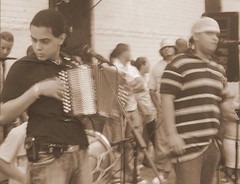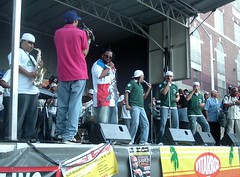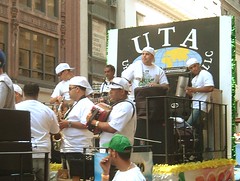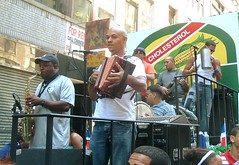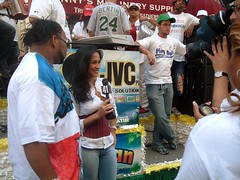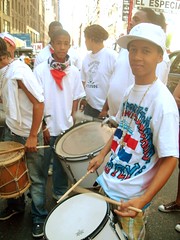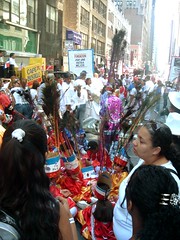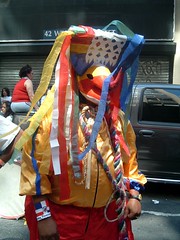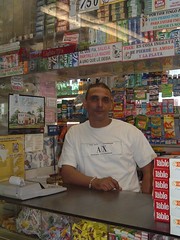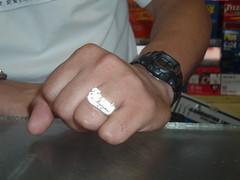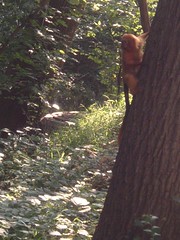Genito and his group, "Geniswing," play at a block party in Bushwick, Brooklyn, 8/20/06. The group ranges in age from approx. 16-20 and all are New York-born Dominicans.
Thursday, August 24, 2006
New York to Tucson
8/14-8/23
After all the excitement, I needed a couple of days to recover, reorganize, and re-move myself to Hanna’s apartment in Carroll Gardens, Brooklyn. But on Wednesday night I was ready once again for fieldwork. It would be the last chance I’d get to go to Macoris for a while, and I needed to say goodbye to all my friends over there. And so I found myself once again on the J train to East New York at 11:00 at night. I arrived to find Leopoldo Santos already playing, the other tables occupied by people unknown to me, who turned out to be a group of Hondurans and a group of Dominicans visiting from North Carolina. Things were tame enough for the first set. In the second, more of my friends arrived, including Chinito (who took a turn on guira) and the US-born contingent, consisting of Geno and some of his bandmates.
When the second set finished it was already 2 AM and I was about ready for bed, but Leopoldo, Tano, Junior, Cesar, and Jesus wouldn’t hear of it: there was no way I could leave without playing, even if I hadn’t practiced in a month and was bound to play badly. So I passed the time with the musicians, standing around outside on the sidewalk as some smoked and the others gossipped. I had some gossip for them tonight, as my sources had told me that Aguakate was going to break up. The news came at a surprising time, as their new CD was coming out this very week, but apparently the lead singer Chino had decided that he wanted to go his own route. The musicians all agreed it had been a bad move to promote the band solely with Chino’s face and personality - even the t-shirt given out at Sunday’s Dominican Day parade had featured only a cartoon of him over the word “Aguakate” - leaving the rest of the band out of the picture entirely. This was especially silly, they thought, because the band members were all accomplished musicians while Chino didn’t even know how to sing, only knew how to be a “personality” and a stage presence. At this point I noticed how funny it was that I was standing on one side of the streetcorner with the Dominican-born musicians, while the American-born kids were standing in their own group on the other, and Chinito (American-born as well, but of the previous generation) went between the two. “Well, those kids are aceitosos,” explained one - they were “slippery” characters. “What do you mean?” I asked. “What do you think they are here for? They’re here to steal the tricks of the guys who are playing!” “But that’s what kids learning how to play do!” I protested. “You can’t tell me that in Tatico’s time, kids weren’t going to his shows and doing the exact same thing.” He conceded this point, but it didn’t change his opinion of their characters.
About 3:00 the third and last set finally got started. I of course had to play a couple of tunes. Then Geno played a couple and his singer joined him, replacing Junior on lead vocals. This didn’t last long, though. One rather drunk seguidor (tipico fan) piped up to complain that the singer was out of tune. He kept up his loud complaints after the next song as well, saying that it “wasn’t out of disrespect” but he “knew a thing or two about music and tuning” and that “someone had to point out the truth.” This was annoying enough that the young man was forced to step down and surrender the mic to Junior again. However, several of us discussing the situation over by the bar agreed that, although the singer was indeed young and had a couple things to work on, we’d heard far worse, and in that very restaurant, no less. I wondered if the complainer was more annoyed by the singing or the fact that the singer was American-born and not yet a part of the transnational tipico crowd, the tightly knit family of musicians and seguidores I’d gotten to know over the years. I pondered the question, but not too much, as it was now past 4 AM and high time to hit the hay.
I passed another entertaining and beer-filled evening on Thursday with my friend Cathy, who showed me around her Astoria, Queens neighborhood, home to an old and huge Greek community and a somewhat newer Arab one. We started out at the Bohemian Beer Garden, a place I’d always meant to visit but never got around to. It is quite the popular place for a beer, with Czech and other interesting East European brews on draft, and its outdoor tables were the perfect spot on this clear, breezy summer evening. But Cathy told me that even just three years ago it hadn’t attracted the crowd of young partiers and hipsters (many of which appeared to hail from Brooklyn, especially Williamsburg) that were there with us. Somehow the word got out. We could have had pierogies and the like right there in the garden, but instead we went across the street to another classic Astoria haunt: Elias’s Corner for Fish, a Greek restaurant where one can get market-fresh fish grilled whole, Greek salads, and retsina. We ate well there, disturbed only by one Greek’s annoying wife, who knocked loudly and long on the window right next to us to attract his attention, gesticulating and making angry faces as he finished dinner with three friends at a neighboring table. Why she did this rather than simply enter and talk to him, perhaps enjoying a glass of retsina that she needed even more than the rest of us, is one of the mysteries of life. Clearly it was time to move on to the dessert portion of the evening, which we had at a corner café and pastry shop whose sidewalk tables were filled with chain-smoking men who tossed their butts not in ashtrays but in glasses of water the waitress brought to every table for just that purpose. The sight was not that appetizing, but the raspberry cake we had was attractive enough to distract us.
With less than a week left, I tried to squeeze in a couple more interviews, events, and visits. Tano promised to meet with me before I left. Would you believe him? No, me neither. My attempts to interview Geno, one of the young American-born accordionists around, also did not work. But then I paid a farewell visit to Arsenio de la Rosa and family in the Bronx, and though King had already left for the DR, we passed a pleasant couple of hours debating merengue history and discussing the interesting recordings I’d found in the Library of Congress. Joe, one of Arsenio’s six children and a hip hop producer, agreed to meet with me to talk about his work with Fulanito and his place in the de la Rosa tipico dynasty, and that did pan out when in an interview at the recording studio he uses.
Aside from these bits of work I also amused myself with friends, like paying a visit to Senti, seeing Tianna at a Stars Like Fleas soundcheck at Tonic, chatting with Danielle about applied ethnomusicology, and going to Red Hook with Hanna. By Saturday I’d already been staying at Hanna’s new Carroll Gardens apartment for several days, but because of our busy social schedules we’d barely seen each other. Thus, on Saturday we decided to do our grocery shopping at the new Fairway supermarket on the Red Hook waterfront, which Hanna promised would offer both gastronomic and surprisingly scenic experiences. Sure enough, it was probably the most picturesque grocery store I’d seen.
On Saturday evening, I decided to check out a ghetto block party Geno’s merengue tipico group would be playing at in the nether reaches of Bushwick, almost to the cemetery whose tombstones could be seen out the L train’s windows as we pulled into the station.. Naturally, when I arrived twenty minutes past the scheduled arrival time, I was almost the first there. I checked out the scene, which consisted of 1970s orquesta merengues blasting from the opposite end of the street, balloon and cotton candy vendors, people selling flan out of their house, and pony rides. This made a cheerful change from the usual, somewhat depressing landscape of flat-fronted brick apartment buildings, narrow houses in faded aluminum siding, and endless dirty asphalt and cement, with no greenery to break up the dismal color palette. Returning to my starting point I found the snubbed singer from Wednesday night at Macoris and another teenage guy I’d seen before both hanging out in front of Geno’s uncle’s bodega, and I joined them. At six, the time the band was supposed to start playing, neither musicians nor equipment was there so we retired to a nearby stoop to sit and discuss the merits of various tipico singers. Eventually Geno showed up with the equipment and other band members, and they went about setting up the instruments and speakers on one side of the store. The oldest of them was only twenty, and the tamborero much younger, perhaps fifteen. The weather, unseasonably chilly, began to look decidedly threatening: bad for me, as I’d left my umbrella at home, and certainly not good for all the electrical wiring now running around the sidewalk. While they finished their preparations, I amused myself by chatting with a couple of Lower East Side-born Dominicans, a plumber and a museum tour guide, who had flatly stated they didn’t believe I could actually play tipico. When the band finally started, I was pleasantly surprised to find that in spite of their age, they all played very well. The youthful tamborero and the guirero even took some solos that were quite impressive. I filmed a bit, since it isn’t often I get to see bands play when it’s still light out. But it did at last start drizzling - not bad enough to drive the assembled crowd away but enough to cause a couple of bodega emplyees to rig up a blue plastic tarp to protect the band and their instruments, tying it to the awning and some street signs and thus obstructing my view. Oh well, that freed me up to enjoy myself a bit, dancing with some local oldsters and buying myself a Corona in a paper bag from the bodega. At their break, the plumber and the guide accompanied me to consume a slice of dollar pizza across the way. Thus sated, I returned to chat with the musicians and they informed me that I HAD to play a couple of tunes as no one there believed I could actually play. Or speak Spanish. I knew I would play badly, not having practiced in a month, but in this situation a mediocre merengue would be better than no merengue. I took the stage, the accordion, and the mic, to make an announcement in Spanish just because I could. The crowd was pleased.
After this, many errands, an excellent dinner out with friend Hanna, a long trip and much hefting of overweight luggage, I now find myself back in Tucson. After seven years of drought the monsoons have finally kicked in and everything is happy and leafy, the mountains greener than I've seen them in 20 years. It's good to be home.
After all the excitement, I needed a couple of days to recover, reorganize, and re-move myself to Hanna’s apartment in Carroll Gardens, Brooklyn. But on Wednesday night I was ready once again for fieldwork. It would be the last chance I’d get to go to Macoris for a while, and I needed to say goodbye to all my friends over there. And so I found myself once again on the J train to East New York at 11:00 at night. I arrived to find Leopoldo Santos already playing, the other tables occupied by people unknown to me, who turned out to be a group of Hondurans and a group of Dominicans visiting from North Carolina. Things were tame enough for the first set. In the second, more of my friends arrived, including Chinito (who took a turn on guira) and the US-born contingent, consisting of Geno and some of his bandmates.
When the second set finished it was already 2 AM and I was about ready for bed, but Leopoldo, Tano, Junior, Cesar, and Jesus wouldn’t hear of it: there was no way I could leave without playing, even if I hadn’t practiced in a month and was bound to play badly. So I passed the time with the musicians, standing around outside on the sidewalk as some smoked and the others gossipped. I had some gossip for them tonight, as my sources had told me that Aguakate was going to break up. The news came at a surprising time, as their new CD was coming out this very week, but apparently the lead singer Chino had decided that he wanted to go his own route. The musicians all agreed it had been a bad move to promote the band solely with Chino’s face and personality - even the t-shirt given out at Sunday’s Dominican Day parade had featured only a cartoon of him over the word “Aguakate” - leaving the rest of the band out of the picture entirely. This was especially silly, they thought, because the band members were all accomplished musicians while Chino didn’t even know how to sing, only knew how to be a “personality” and a stage presence. At this point I noticed how funny it was that I was standing on one side of the streetcorner with the Dominican-born musicians, while the American-born kids were standing in their own group on the other, and Chinito (American-born as well, but of the previous generation) went between the two. “Well, those kids are aceitosos,” explained one - they were “slippery” characters. “What do you mean?” I asked. “What do you think they are here for? They’re here to steal the tricks of the guys who are playing!” “But that’s what kids learning how to play do!” I protested. “You can’t tell me that in Tatico’s time, kids weren’t going to his shows and doing the exact same thing.” He conceded this point, but it didn’t change his opinion of their characters.
About 3:00 the third and last set finally got started. I of course had to play a couple of tunes. Then Geno played a couple and his singer joined him, replacing Junior on lead vocals. This didn’t last long, though. One rather drunk seguidor (tipico fan) piped up to complain that the singer was out of tune. He kept up his loud complaints after the next song as well, saying that it “wasn’t out of disrespect” but he “knew a thing or two about music and tuning” and that “someone had to point out the truth.” This was annoying enough that the young man was forced to step down and surrender the mic to Junior again. However, several of us discussing the situation over by the bar agreed that, although the singer was indeed young and had a couple things to work on, we’d heard far worse, and in that very restaurant, no less. I wondered if the complainer was more annoyed by the singing or the fact that the singer was American-born and not yet a part of the transnational tipico crowd, the tightly knit family of musicians and seguidores I’d gotten to know over the years. I pondered the question, but not too much, as it was now past 4 AM and high time to hit the hay.
I passed another entertaining and beer-filled evening on Thursday with my friend Cathy, who showed me around her Astoria, Queens neighborhood, home to an old and huge Greek community and a somewhat newer Arab one. We started out at the Bohemian Beer Garden, a place I’d always meant to visit but never got around to. It is quite the popular place for a beer, with Czech and other interesting East European brews on draft, and its outdoor tables were the perfect spot on this clear, breezy summer evening. But Cathy told me that even just three years ago it hadn’t attracted the crowd of young partiers and hipsters (many of which appeared to hail from Brooklyn, especially Williamsburg) that were there with us. Somehow the word got out. We could have had pierogies and the like right there in the garden, but instead we went across the street to another classic Astoria haunt: Elias’s Corner for Fish, a Greek restaurant where one can get market-fresh fish grilled whole, Greek salads, and retsina. We ate well there, disturbed only by one Greek’s annoying wife, who knocked loudly and long on the window right next to us to attract his attention, gesticulating and making angry faces as he finished dinner with three friends at a neighboring table. Why she did this rather than simply enter and talk to him, perhaps enjoying a glass of retsina that she needed even more than the rest of us, is one of the mysteries of life. Clearly it was time to move on to the dessert portion of the evening, which we had at a corner café and pastry shop whose sidewalk tables were filled with chain-smoking men who tossed their butts not in ashtrays but in glasses of water the waitress brought to every table for just that purpose. The sight was not that appetizing, but the raspberry cake we had was attractive enough to distract us.
With less than a week left, I tried to squeeze in a couple more interviews, events, and visits. Tano promised to meet with me before I left. Would you believe him? No, me neither. My attempts to interview Geno, one of the young American-born accordionists around, also did not work. But then I paid a farewell visit to Arsenio de la Rosa and family in the Bronx, and though King had already left for the DR, we passed a pleasant couple of hours debating merengue history and discussing the interesting recordings I’d found in the Library of Congress. Joe, one of Arsenio’s six children and a hip hop producer, agreed to meet with me to talk about his work with Fulanito and his place in the de la Rosa tipico dynasty, and that did pan out when in an interview at the recording studio he uses.
Aside from these bits of work I also amused myself with friends, like paying a visit to Senti, seeing Tianna at a Stars Like Fleas soundcheck at Tonic, chatting with Danielle about applied ethnomusicology, and going to Red Hook with Hanna. By Saturday I’d already been staying at Hanna’s new Carroll Gardens apartment for several days, but because of our busy social schedules we’d barely seen each other. Thus, on Saturday we decided to do our grocery shopping at the new Fairway supermarket on the Red Hook waterfront, which Hanna promised would offer both gastronomic and surprisingly scenic experiences. Sure enough, it was probably the most picturesque grocery store I’d seen.
On Saturday evening, I decided to check out a ghetto block party Geno’s merengue tipico group would be playing at in the nether reaches of Bushwick, almost to the cemetery whose tombstones could be seen out the L train’s windows as we pulled into the station.. Naturally, when I arrived twenty minutes past the scheduled arrival time, I was almost the first there. I checked out the scene, which consisted of 1970s orquesta merengues blasting from the opposite end of the street, balloon and cotton candy vendors, people selling flan out of their house, and pony rides. This made a cheerful change from the usual, somewhat depressing landscape of flat-fronted brick apartment buildings, narrow houses in faded aluminum siding, and endless dirty asphalt and cement, with no greenery to break up the dismal color palette. Returning to my starting point I found the snubbed singer from Wednesday night at Macoris and another teenage guy I’d seen before both hanging out in front of Geno’s uncle’s bodega, and I joined them. At six, the time the band was supposed to start playing, neither musicians nor equipment was there so we retired to a nearby stoop to sit and discuss the merits of various tipico singers. Eventually Geno showed up with the equipment and other band members, and they went about setting up the instruments and speakers on one side of the store. The oldest of them was only twenty, and the tamborero much younger, perhaps fifteen. The weather, unseasonably chilly, began to look decidedly threatening: bad for me, as I’d left my umbrella at home, and certainly not good for all the electrical wiring now running around the sidewalk. While they finished their preparations, I amused myself by chatting with a couple of Lower East Side-born Dominicans, a plumber and a museum tour guide, who had flatly stated they didn’t believe I could actually play tipico. When the band finally started, I was pleasantly surprised to find that in spite of their age, they all played very well. The youthful tamborero and the guirero even took some solos that were quite impressive. I filmed a bit, since it isn’t often I get to see bands play when it’s still light out. But it did at last start drizzling - not bad enough to drive the assembled crowd away but enough to cause a couple of bodega emplyees to rig up a blue plastic tarp to protect the band and their instruments, tying it to the awning and some street signs and thus obstructing my view. Oh well, that freed me up to enjoy myself a bit, dancing with some local oldsters and buying myself a Corona in a paper bag from the bodega. At their break, the plumber and the guide accompanied me to consume a slice of dollar pizza across the way. Thus sated, I returned to chat with the musicians and they informed me that I HAD to play a couple of tunes as no one there believed I could actually play. Or speak Spanish. I knew I would play badly, not having practiced in a month, but in this situation a mediocre merengue would be better than no merengue. I took the stage, the accordion, and the mic, to make an announcement in Spanish just because I could. The crowd was pleased.
After this, many errands, an excellent dinner out with friend Hanna, a long trip and much hefting of overweight luggage, I now find myself back in Tucson. After seven years of drought the monsoons have finally kicked in and everything is happy and leafy, the mountains greener than I've seen them in 20 years. It's good to be home.
Sunday, August 20, 2006
Aguakate in Washington Heights
Aguakate plays at Dominican Day festival on Amsterdam Ave., Washington Heights.
Aguakate in Dominican Day Parade
Aguakate band members on their float for the 2006 Dominican Day Parade.
Chino on the news
Chino, Aguakate's frontman, gets interviewed for Spanish-language news in front of Aguakate's float for the Dominican Day parade.
Dominican Day Parade
8/12-8/13
It was the weekend of the Dominican Day parade in New York. I’d never been before, just because I don’t feel much attraction to the idea of being crushed in a crowd of hundreds of thousands of people under the sun for hours on end. But I figured I ought to check it out before I leave. The parade itself wasn’t until Sunday, but the festivities started on Saturday in Washington Heights, where a couple of blocks of Amsterdam Avenue (from about 191 to 194) had been closed off to make way for food and vendor stalls and two stages, one at either end. The street’s topography worked pretty well for security purposes: a steep cliff rises up on the west side and another one drops straight down to the East River on the other side, so one could only enter at one of the ends where police had set up barriers and were checking bags. Mine passed muster so I went in.
The music hadn’t started yet, so I examined the booths (Interboro college, Chevrolet, Citibank, and Lemisol feminine wash were all represented) and the food offerings (there seemed, oddly, to be more Puerto Rican and Colombian restaurants represented than Dominican ones). I got myself a crabmeat empanada and a cheese-filled Colombian arepa, then a mango juice to round off the meal. There was a DJ at work but he didnt play any merengue tipico the whole time, mostly only merengue de orquesta and reggaeton. But eventually things started happening on stage. First, three girls barely in their teens wearing red tops and extremely short white skirts, dancing reggaeton rather well. After a few minutes they were joined by three slightly older girls in much more modest overalls. They were actually pretty good with the reggaeton-style rapping, though it’s not my favorite type of music. The second act was also girls singing reggaeton (is this a new New York Dominican thing?), but this time just a pair of them in camouflage outfits. As they performed some actual instruments were being set up behind them, and soon enough I saw that the guitar belonged to Edilio Paredes, a musician I’ve known for some time, known mostly for his bachata guitar work but also started playing accordion a few years back and is now very good on that too. He plays with a bunch of bands like Super Uba, but today was backing up some singer called “Nelson Maicky,” whoever that is. So even though I was kind of tired of the sun in my eyes, my perch on the edge of a metal traffic barrier, and the stupid wasp that seemed enamored of me and my sun block, I stuck around for a bit to see. But only for a little bit. There would be plenty more of this tomorrow, I was sure.
My old friend Alejandro, bass player for Aguakate, had informed me that his group would be performing on a float in the parade. He suggested I join up with them so as to avoid the madding crowds. This sounded like a good idea but there was some confusion about where and when they’d be meeting. After several rounds of phone calls, we got it all figured out and I went up to find them on 38th street, where the block between 5th and 6th avenues had been closed off to allow the floats, marchers, and all space in which to prepare themselves. On the way up, I bought a Dominican flag bandana to tie to a belt loop and show my spirit, and then found myself unexpectedly accompanied by several dozen teenagers in patriotic Dominican bandanas, t-shirts, and even the occasional umbrella hat. Several of them had guiras and one had a tambora, and they went along playing merengue rhythms and improvising rousing choruses. As they passed by one footwear store on 34th Street, one of the salesmen (apparently Dominican) came out and led them in a chant: “We got shoes! We got shoes!”
Up on 38th, I strolled around examining the offerings, which included floats for products like La Mazorca corn oil and Vitarroz rice, music companies like one for “Hip hop Dominican style,” and organizations like the Centro Civico (Dominican Civic Center) in Washington Heights. The Tamboril community organization for Dominican immigrants from that town near Santiago also had its own truck. Besides all the Dominican businesses and groups there was also a Mexican marching band and a big decorated Colombian bus with all kinds of sacks strapped on top as if it were about to make a long journey through some mountain towns, though with a bunch of Dominican flags stuck on the side for the occasion. Not on floats but getting into their costumes to work the parade route on foot were carnival groups representing Las Guloyas (a cocolo tradition), the city of La Vega and the town of Cabral, where I’d been for carnival just a few months before. I was surprised to recognize their cachua costumes and went over for a closer look. Imagine my surprise to find one of them was actually Temistocle, whose house I’d visited in order to purchase one of his homemade, multicolored whips. He’d come to New York for two weeks just for this occasion, teaching New York Dominican kids about the cachua tradition in the process. I also found another accordionist I knew, Fidel, was performing with his band on the Mazorca float. Good to see tipico would be well represented in the parade.
We had been told to be there at 12 noon, and to make this schedule the musicians of Aguakate had gone without any sleep at all. They’d been playing a gig in some other state - Connecticut? - and only arrived back in the city around 7 AM, then had to meet at Peligro’s store again at 10 AM. That was just about enough time to change clothes and eat. Fat lot of good it did - we spent three hours standing around, fueled only by the beer and rum some members had brought or purchased nearby. Members entertained themselves by improvising verses over their microphones to accompany the carnival percussion group composed of kids in custom airbrushed t-shirts featuring the likenesses of Dominican baseball players or else green plantains and the label “platano,” another word for Dominicans abroad. Some people strolling by stopped to get the autograph of or take pictures with Chino, Aguakate’s frontman. I took advantage of the moment to snap my own shot. But we were all glad when at last the floats began to move (though of course the driver had disappeared at that point and had to be located by making announcements over the float’s sound system).
No one was allowed on the float other than band members and the people representing the phone card company that sponsored it (girls in short tops and guys handing out free Aguakate t-shirts to the crowd). So I was relegated to walking alongside it with Peligro, his cousin, and assorted teenage rabblerousers sporting the official t-shirts and getting the crowd pumped up with their enthusiasm and antics. I hadn’t really expected to be IN the parade, but in fact I found it quite enjoyable for four blocks to walk along Sixth Avenue, right past Bryant Park, and smile at the thousands of flag-waving Dominicans. But at 42nd street the float made an unexpected right turn, allowing the Mexican marching band to move ahead of us up the avenue. I soon found out that we’d been pulled from the parade as one of those boys on the ground had resisted a police officer trying to pull him out, apparently not knowing he was a participant. He’d been handcuffed for this and the entire group pulled as a result. There was some talk about circling back around and rejoining the parade where we’d started, but this never happened, and when we came back around to Sixth Ave the whole thing had already passed, leaving only streets full of trash and streetsweeping machines. Peligro, his cousin, some of the troublemakers, and I then passed an inordinate amount of time wandering around midtown Manhattan trying to reunite with the band, which eventually we did, over on Eighth Ave where they had just gone ahead and started dismantling the float covered in green, white, and yellow streamers. Alejandro said, “this is why I hired someone else to play in my place in last year’s parade.” But I was still glad I’d gone.
Aguakate still had three more gigs to play that day before they could sleep. I decided to accompany them to the next, which was up on Amsterdam and 191st, where I’d been the day before. I hung out with them and the other bands backstage before they went on, avoiding the crowds, much larger and crazier than the day before, then went around front to film while they were on. Chino got a little political, commenting unfavorably on the new law enacted by DR President Leonel Fernandez a couple of weeks ago, which prohibits nightclubs from having live music after midnight and weekdays and after 2 AM on weekends. I, on the other hand, was more than a little in favor of this measure, which will make my fieldwork much easier next year!
I expected to be able to return to my Upper West Side digs quickly, as it was really only ten stops away on the 1 train. But I hadn’t seen the crowds wandering the streets of Washington Heights in celebration of Dominican pride. The police had blocked off Amsterdam so effectively that there was a huge pedestrian traffic jam at the 190th street exit from the festival, since only a trickle of people could get through the single-file opening they’d left. Once I made it through that, I had to walk over to Broadway through masses of people, many of them enjoying the antics of passers by from the comfort of lawn chairs they’d lined up along the sidewalks in front of their apartment buildings. Getting into the elevator down to the train platform and them moving along that platform was no picnic, either. Eventually I managed to get on a train, and feeling much relieved, settled down to read my book. But the train stopped at 168th Street and we were waiting for a long, long time, held up in the station for unknown reasons. A couple of guys on my car were making a lot of rambunctious noise. I didn’t know if they were troublemakers or simply in high spirits, so I kept my eyes on them, and when I saw that one was had a large knife stuck into the front of his waistband I decided switching cars might be a good idea. I did this, and just as I’d sat down the conductor announced the doors were malfunctioning and we’d all have to get off. I exited the train and heard someone call my name. Another surprise: it was Luis, a guy I’d known from the Centro Leon in Santiago. I didn’t recognize him at first in his baseball cap, jeans, and jersey, having only seen him in his work attire of khaki pants and long-sleeve, button-down shirts before. Small world!
I was doubly glad to be with someone I knew another minute later. As the crowd waited on the platform, two different gangs had met two cars down for us and they started fighting. Not knowing what kind of weaponry they might have on them, we all started to run, and as I did so, I thought of stories of people getting crushed in stampeding crowds.. Luis guided me and his other friends by the elbow to a less crowded staircase, and we sprinted up to find the elevator open but full and just about to leave. We pressed ourselves in anyway and went up. At the top we stopped to catch our breath and decide what to do next. I thought of going up and taking the bus instead, but Luis cautioned that it could be as bad or worse on the topside. Instead we waited until we saw police go down and figured things had calmed enough to descend once again. I got home safe and sound, and just in time for Hanna to come by for happy hour.
It was the weekend of the Dominican Day parade in New York. I’d never been before, just because I don’t feel much attraction to the idea of being crushed in a crowd of hundreds of thousands of people under the sun for hours on end. But I figured I ought to check it out before I leave. The parade itself wasn’t until Sunday, but the festivities started on Saturday in Washington Heights, where a couple of blocks of Amsterdam Avenue (from about 191 to 194) had been closed off to make way for food and vendor stalls and two stages, one at either end. The street’s topography worked pretty well for security purposes: a steep cliff rises up on the west side and another one drops straight down to the East River on the other side, so one could only enter at one of the ends where police had set up barriers and were checking bags. Mine passed muster so I went in.
The music hadn’t started yet, so I examined the booths (Interboro college, Chevrolet, Citibank, and Lemisol feminine wash were all represented) and the food offerings (there seemed, oddly, to be more Puerto Rican and Colombian restaurants represented than Dominican ones). I got myself a crabmeat empanada and a cheese-filled Colombian arepa, then a mango juice to round off the meal. There was a DJ at work but he didnt play any merengue tipico the whole time, mostly only merengue de orquesta and reggaeton. But eventually things started happening on stage. First, three girls barely in their teens wearing red tops and extremely short white skirts, dancing reggaeton rather well. After a few minutes they were joined by three slightly older girls in much more modest overalls. They were actually pretty good with the reggaeton-style rapping, though it’s not my favorite type of music. The second act was also girls singing reggaeton (is this a new New York Dominican thing?), but this time just a pair of them in camouflage outfits. As they performed some actual instruments were being set up behind them, and soon enough I saw that the guitar belonged to Edilio Paredes, a musician I’ve known for some time, known mostly for his bachata guitar work but also started playing accordion a few years back and is now very good on that too. He plays with a bunch of bands like Super Uba, but today was backing up some singer called “Nelson Maicky,” whoever that is. So even though I was kind of tired of the sun in my eyes, my perch on the edge of a metal traffic barrier, and the stupid wasp that seemed enamored of me and my sun block, I stuck around for a bit to see. But only for a little bit. There would be plenty more of this tomorrow, I was sure.
My old friend Alejandro, bass player for Aguakate, had informed me that his group would be performing on a float in the parade. He suggested I join up with them so as to avoid the madding crowds. This sounded like a good idea but there was some confusion about where and when they’d be meeting. After several rounds of phone calls, we got it all figured out and I went up to find them on 38th street, where the block between 5th and 6th avenues had been closed off to allow the floats, marchers, and all space in which to prepare themselves. On the way up, I bought a Dominican flag bandana to tie to a belt loop and show my spirit, and then found myself unexpectedly accompanied by several dozen teenagers in patriotic Dominican bandanas, t-shirts, and even the occasional umbrella hat. Several of them had guiras and one had a tambora, and they went along playing merengue rhythms and improvising rousing choruses. As they passed by one footwear store on 34th Street, one of the salesmen (apparently Dominican) came out and led them in a chant: “We got shoes! We got shoes!”
Up on 38th, I strolled around examining the offerings, which included floats for products like La Mazorca corn oil and Vitarroz rice, music companies like one for “Hip hop Dominican style,” and organizations like the Centro Civico (Dominican Civic Center) in Washington Heights. The Tamboril community organization for Dominican immigrants from that town near Santiago also had its own truck. Besides all the Dominican businesses and groups there was also a Mexican marching band and a big decorated Colombian bus with all kinds of sacks strapped on top as if it were about to make a long journey through some mountain towns, though with a bunch of Dominican flags stuck on the side for the occasion. Not on floats but getting into their costumes to work the parade route on foot were carnival groups representing Las Guloyas (a cocolo tradition), the city of La Vega and the town of Cabral, where I’d been for carnival just a few months before. I was surprised to recognize their cachua costumes and went over for a closer look. Imagine my surprise to find one of them was actually Temistocle, whose house I’d visited in order to purchase one of his homemade, multicolored whips. He’d come to New York for two weeks just for this occasion, teaching New York Dominican kids about the cachua tradition in the process. I also found another accordionist I knew, Fidel, was performing with his band on the Mazorca float. Good to see tipico would be well represented in the parade.
We had been told to be there at 12 noon, and to make this schedule the musicians of Aguakate had gone without any sleep at all. They’d been playing a gig in some other state - Connecticut? - and only arrived back in the city around 7 AM, then had to meet at Peligro’s store again at 10 AM. That was just about enough time to change clothes and eat. Fat lot of good it did - we spent three hours standing around, fueled only by the beer and rum some members had brought or purchased nearby. Members entertained themselves by improvising verses over their microphones to accompany the carnival percussion group composed of kids in custom airbrushed t-shirts featuring the likenesses of Dominican baseball players or else green plantains and the label “platano,” another word for Dominicans abroad. Some people strolling by stopped to get the autograph of or take pictures with Chino, Aguakate’s frontman. I took advantage of the moment to snap my own shot. But we were all glad when at last the floats began to move (though of course the driver had disappeared at that point and had to be located by making announcements over the float’s sound system).
No one was allowed on the float other than band members and the people representing the phone card company that sponsored it (girls in short tops and guys handing out free Aguakate t-shirts to the crowd). So I was relegated to walking alongside it with Peligro, his cousin, and assorted teenage rabblerousers sporting the official t-shirts and getting the crowd pumped up with their enthusiasm and antics. I hadn’t really expected to be IN the parade, but in fact I found it quite enjoyable for four blocks to walk along Sixth Avenue, right past Bryant Park, and smile at the thousands of flag-waving Dominicans. But at 42nd street the float made an unexpected right turn, allowing the Mexican marching band to move ahead of us up the avenue. I soon found out that we’d been pulled from the parade as one of those boys on the ground had resisted a police officer trying to pull him out, apparently not knowing he was a participant. He’d been handcuffed for this and the entire group pulled as a result. There was some talk about circling back around and rejoining the parade where we’d started, but this never happened, and when we came back around to Sixth Ave the whole thing had already passed, leaving only streets full of trash and streetsweeping machines. Peligro, his cousin, some of the troublemakers, and I then passed an inordinate amount of time wandering around midtown Manhattan trying to reunite with the band, which eventually we did, over on Eighth Ave where they had just gone ahead and started dismantling the float covered in green, white, and yellow streamers. Alejandro said, “this is why I hired someone else to play in my place in last year’s parade.” But I was still glad I’d gone.
Aguakate still had three more gigs to play that day before they could sleep. I decided to accompany them to the next, which was up on Amsterdam and 191st, where I’d been the day before. I hung out with them and the other bands backstage before they went on, avoiding the crowds, much larger and crazier than the day before, then went around front to film while they were on. Chino got a little political, commenting unfavorably on the new law enacted by DR President Leonel Fernandez a couple of weeks ago, which prohibits nightclubs from having live music after midnight and weekdays and after 2 AM on weekends. I, on the other hand, was more than a little in favor of this measure, which will make my fieldwork much easier next year!
I expected to be able to return to my Upper West Side digs quickly, as it was really only ten stops away on the 1 train. But I hadn’t seen the crowds wandering the streets of Washington Heights in celebration of Dominican pride. The police had blocked off Amsterdam so effectively that there was a huge pedestrian traffic jam at the 190th street exit from the festival, since only a trickle of people could get through the single-file opening they’d left. Once I made it through that, I had to walk over to Broadway through masses of people, many of them enjoying the antics of passers by from the comfort of lawn chairs they’d lined up along the sidewalks in front of their apartment buildings. Getting into the elevator down to the train platform and them moving along that platform was no picnic, either. Eventually I managed to get on a train, and feeling much relieved, settled down to read my book. But the train stopped at 168th Street and we were waiting for a long, long time, held up in the station for unknown reasons. A couple of guys on my car were making a lot of rambunctious noise. I didn’t know if they were troublemakers or simply in high spirits, so I kept my eyes on them, and when I saw that one was had a large knife stuck into the front of his waistband I decided switching cars might be a good idea. I did this, and just as I’d sat down the conductor announced the doors were malfunctioning and we’d all have to get off. I exited the train and heard someone call my name. Another surprise: it was Luis, a guy I’d known from the Centro Leon in Santiago. I didn’t recognize him at first in his baseball cap, jeans, and jersey, having only seen him in his work attire of khaki pants and long-sleeve, button-down shirts before. Small world!
I was doubly glad to be with someone I knew another minute later. As the crowd waited on the platform, two different gangs had met two cars down for us and they started fighting. Not knowing what kind of weaponry they might have on them, we all started to run, and as I did so, I thought of stories of people getting crushed in stampeding crowds.. Luis guided me and his other friends by the elbow to a less crowded staircase, and we sprinted up to find the elevator open but full and just about to leave. We pressed ourselves in anyway and went up. At the top we stopped to catch our breath and decide what to do next. I thought of going up and taking the bus instead, but Luis cautioned that it could be as bad or worse on the topside. Instead we waited until we saw police go down and figured things had calmed enough to descend once again. I got home safe and sound, and just in time for Hanna to come by for happy hour.
Dominican Day parade- cachua
This guy in a cachua costume is actually Temistocle, whose house I visited in Cabral back in April! He made my whip, which is much like the one over his shoulder in this picture.
Monday, August 14, 2006
Subscribe to:
Posts (Atom)

